Black is Beautiful
Each year for the past nine years, Robert Zohn, owner of Value Electronics in Scarsdale, NY, has put the year's top-performing flat panel televisions on display, side by side, in an effort to determine the best TV of the year. It's called the Flat Panel Shootout and it's a cool way to geek out on the latest display technology and really compare the top performers head to head. I attended day one of the shootout earlier this month and, even though I've seen most of these sets up close before (and have one of them in the labs for review), I was able to learn a thing or two about these TVs.
It's important to note that Robert doesn't just plug the TVs in, put on a movie and say, "What do you think?" He brings in talented TV calibrators to wring every ounce of performance out of these sets so each can look its best. This year's calibrators included Dewayne "D-Nice" Davis, David Mackenzie of HDTV Test in the UK, and Kevin Miller, one of the co-founders of the Imaging Science Foundation (ISF) and a Level II ISF calibration instructor. As with previous years, the content we viewed included test patterns and clips as well as movie clips.
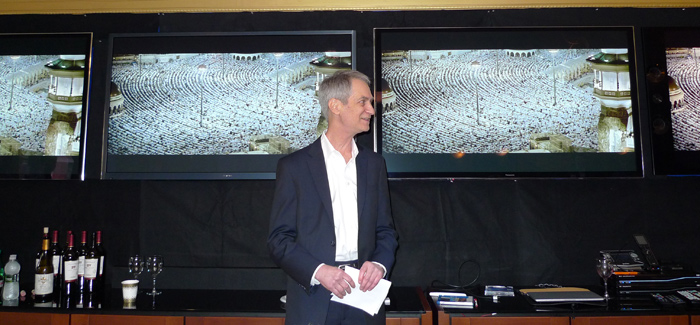

All of the sets looked good on actual movie content, though there were clear performance differences among them. These differences became clearer when viewing test patterns and test clips. We looked at zone plates, grey scale bars, color bars, motion resolution tests and much more, over the course of a few hours on a warm spring night.
Along the way, attendees recorded their preferences in the form of scores (1-10) for the various elements that make a good picture: black level, contrast ratio, color accuracy, moving picture resolution, and overall picture quality. This year a new category was added for "Day mode" - the ability for the TV to produce a pleasing image in a bright room. One might think this would have given the LED-lit LCD sets an advantage to to their higher brightness, but the actual results were a bit surprising.
This year's contenders included three plasmas and three LED-lit LCD TVs. The models were:
As was the case last year, the plasma TVs outperformed the LED/LCD sets overall, by a fairly wide margin. Even the mighty 4K "Ultra HD" Sony LED TV was bested by the three 1080p plasma sets from Panasonic and Samsung. Of course, we did not view any native 4K content (of which there is currently very little) on the Sony. Doing so would surely have highlighted its strengths in picture detail. But one might have expected its greater resolution and scaling would have given it an edge over the competition even on regular HD material. It turns out many other areas of display performance are more important than the number of pixels, so the Sony finished off around the middle of the pack.
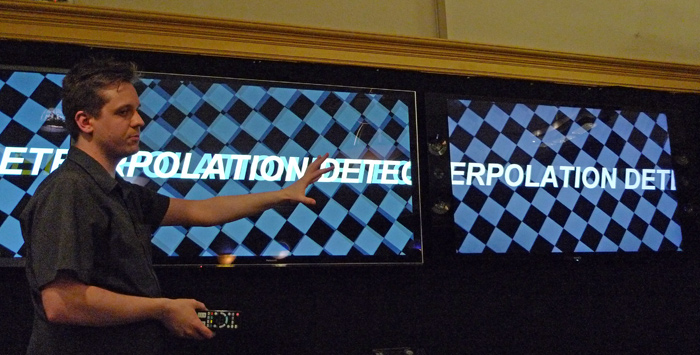
In the LED department, two things stood out to me: how much better the Samsung F8000 looked compared to last year's top of the line set and how poorly the Panasonic LED/LCD set performed on the test patterns. The Samsung F8000 featured much improved lighting uniformity. Black levels, while not reaching those of the plasma sets, were solid and uniform. I didn't see as much of the hot-spotting or bright splotches around the edges as with earlier Samsung LED sets. The Panasonic LED set, on the other hand, had trouble reproducing a clean gray scale or a deep black level. Its color accuracy was good, but it lacked the deep color saturation of the plasmas.
Among the three plasma TVs, the Samsung F8500 produced a surprisingly bright picture compared to the other two, while still maintaining excellent black levels. It could not quite match the deep dark inky blacks of the Panasonic sets, but it made up for it with superior brightness. This is most likely what earned the F8500 the highest scores in the "Day Mode" category. Those who shy away from plasma sets due to their lower overall brightness levels will want to take a close look at the F8500. The calibration team said that the calibrated sets were all tuned to a light output of 40 foot lamberts, but the VT60 plasma could only reach 35 foot lamberts while the ZT60 maxed out at 30 foot lamberts. The cuplrit here is most likely the special screen filter that the ZT60 uses to accentuate black levels and reject ambient room light. It does enhance the perceived black levels in a bright room, but at the cost of lower overall brightness.
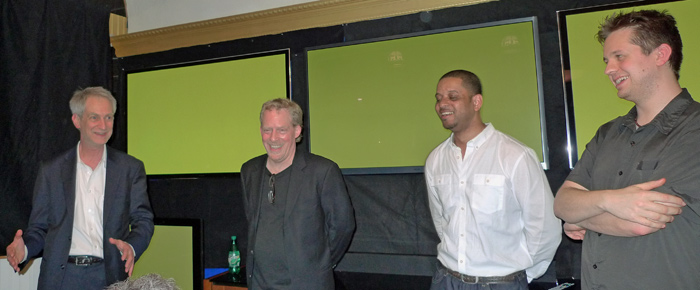
In terms of who "won" the competition, based on the popular votes, the Samsung F8500 plasma eked out a win over the Panasonic plasma sets and trounced the LED/LCD competition. Attendees noted its bright whites, excellent color saturation and overall dynamic picture quality.
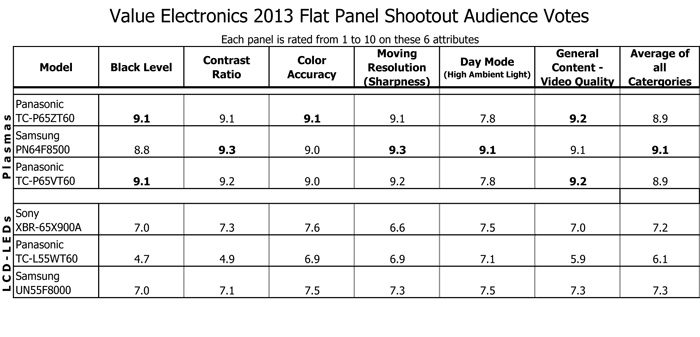
If you look only at the Expert votes (including the calibrators), first and second place were reversed with the Panasonic sets tied for first and the Samsung plasma taking second place.
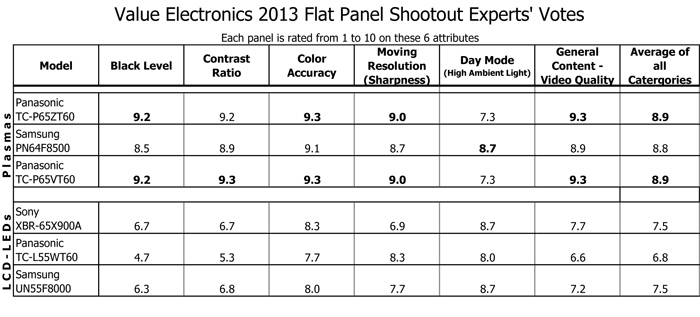
The set that took top honors for me was the Panasonic ZT60 plasma (overall score: 9.17), followed by the Samsung F8500 (score: 9.0) as an extremely close second and the Panasonic VT60 right behind that (score: 8.83). Although the two Panasonics offered virtually identical black level performance in a dark room, the ZT60's filter gave the set a slight edge in a brighter room (in my opinion).
I have to say though: I could happily live with any of the top 3 sets (Samsung F8500, Panasonic VT60, Panasonic ZT60), so my recommendation would depend on the viewing habits of the prospective buyer. If you control your viewing environment's lighting, then I would recommend the VT60 as it offers nearly identical performance to the ZT60 at a lower cost. And if you watch a lot of TV in a bright environment, then the edge goes to the Samsung F8500 for its higher brightness. But for mixed viewing, I preferred the ZT60 overall. Its black levels were superior in night time viewing, and still looked deep and rich in a room that had a fair amount of ambient light.
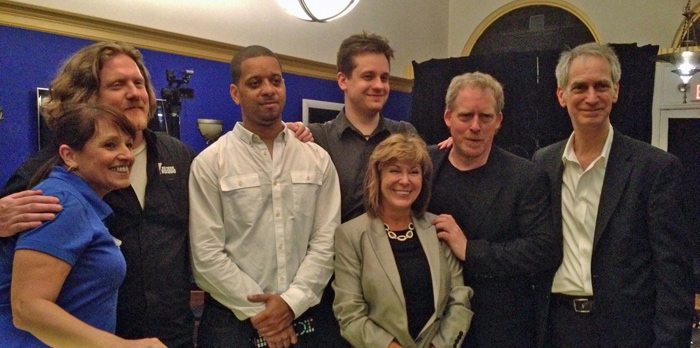
As is tradition at the Flat Panel Shootouts, the team brought out a "mystery contender" to challenge this year's top performers. This was Robert's personal Pioneer Kuro plasma (KRP-500M), one of the last to roll off Pioneer's assembly lines before they abandoned the TV business a few years ago. To many, the Kuro represents the ultimate in picture quality, even to this day. In my opnion, the black levels between the Panasonic sets and the Pioneer in a darkened room were almost too close to call with perhaps a slight edge still going to the Kuro. But in other areas of performance (moving picture resolution, for example), the Panasonic and Samsung sets had the edge. Is the Kuro still an excellent set, even by comparison to day's best? For sure. But the Panasonic and Samsung plasmas definitely held their own against it.
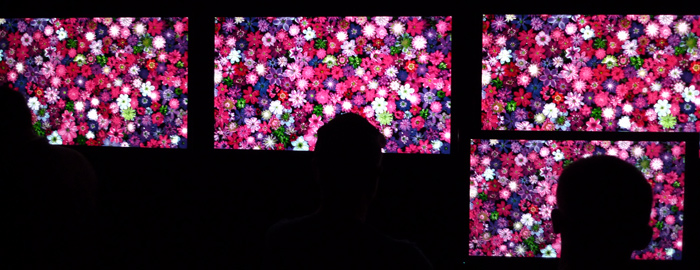
Of the LED sets, I would give the Samsung F8000 the edge over the Sony Ultra HD set, with the Panasonic LED set my least favorite of those on display here. This is not to say it is the worst TV on the market (far from it), only that it could not compete effectively with these other top of the line sets.
Stay tuned for our upcoming reviews of the Samsung F8500 and Panasonic VT60 plasma TVs (coming soon).
More Information on the Flat Panel Shootout: